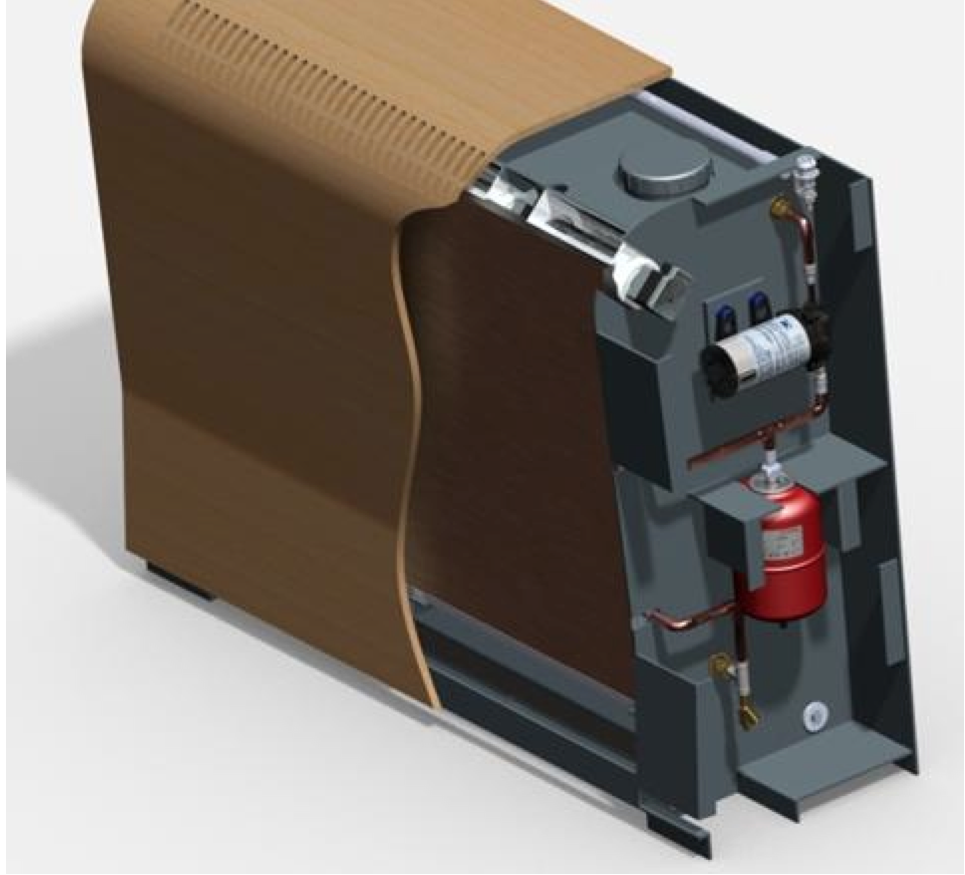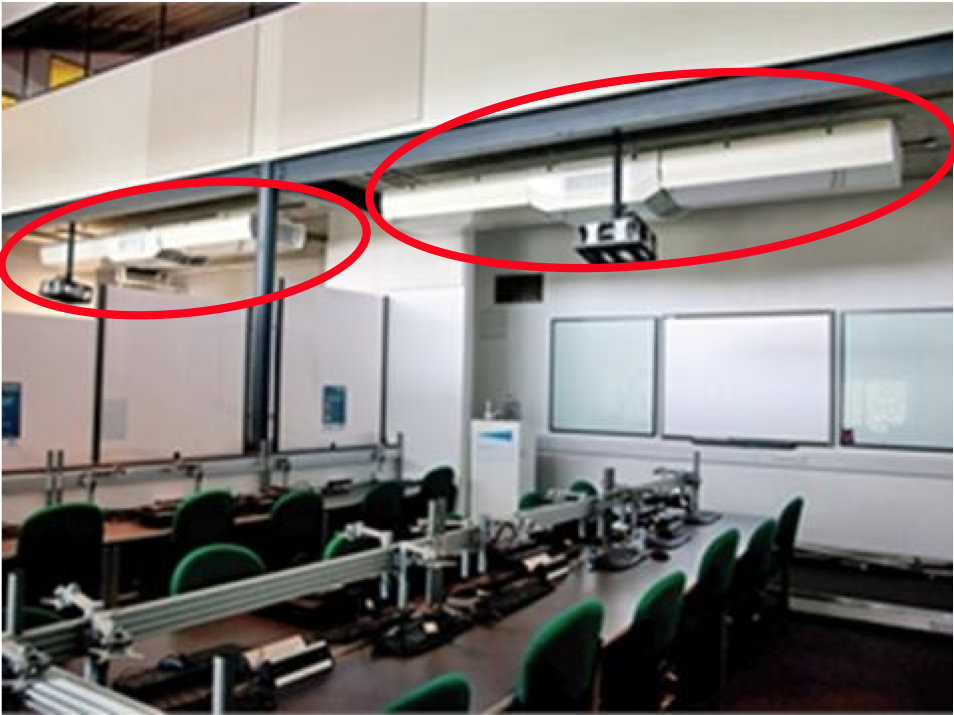The Development of a Viable Low-Energy Alternative to Air Conditioning
Submitting Institution
University of NottinghamUnit of Assessment
Architecture, Built Environment and PlanningSummary Impact Type
TechnologicalResearch Subject Area(s)
Engineering: Interdisciplinary Engineering
Summary of the impact
Research at the University of Nottingham into the use of phase- change
materials as a means for heating and cooling buildings has resulted in the
development of COOL-PHASE®, a product which is sold by Monodraught ltd.
The system was launched in 2008 and has been installed in 136 buildings in
the UK. COOL-PHASE® underpins the long-term growth strategy for the
company and Monodraught has invested in employing 3 new staff and £250k in
capital expenditure to make the unit suitable for mass production.
Underpinning research
Global warming has brought an increased dependence on air-conditioning
and a growing demand for high-efficiency, lower-energy cooling systems. A
simple way to satisfy these would be to incorporate concrete beams within
a structure, exploiting the effect of night cooling to discharge heat
stored in the thermal mass during the day. However, this solution is
unsuitable for retrofit in existing buildings, which is where the greatest
energy saving potential lies.
In the late 1990s, recognising the need for alternatives to conventional
air conditioning, researchers at the University of Nottingham (UoN) began
work to reduce energy consumption and avoid the use of refrigerant
chemicals in potential systems. Dr David Etheridge (Associate Professor,
University of Nottingham, 1997 - 2010) performed the original research on
natural ventilation [2.1, 2.2] and led the team, with other key members
including Visiting Professor David Reay (appointed honorary professor,
University of Nottingham, 1994 — present) and Professor Saffa Riffat
(Chair in Sustainable Energy, University of Nottingham, 1992 — present) to
investigate the potential for combining natural ventilation with
phase-change materials (PCM) within a retrofittable unit to increase the
effective thermal mass of a building (EPSRC GR/R21639/01).
PCMs store energy in the form of latent heat and are more efficient than
concrete, typically achieving the same heat storage with just four per
cent of the mass. During the day heat is transferred to the PCM, "melting"
it and reducing the temperature of the room; whilst at night heat is
extracted from the PCM, "solidifying it".
Researchers faced several challenges in the process of developing the
system, which was supported through the use of a new theoretical model
[2.3]. The initial idea was to use PCM in conjunction with heat pipes and
a fan to make the system more effective. Heat pipes have the advantage of
offering high heat transfer rates and are easy to maintain. The team also
needed to find a way of making them reversible, meaning they would operate
in a horizontal position.
Intelligent controls were designed to run this with minimal energy
consumption. To allow for the expansion and contraction that occurs during
the operating cycle, the system needed to be housed in a way that enabled
heat transfer with the air in the room but without it coming into direct
contact, which could result in air contamination. Lastly, the final
product needed to be suitable for manufacturing at a cost that would rival
or outperform conventional mass-produced air conditioning units [2.4].
Enthused by the potential of the technology, UoN liaised with industry to
gain commercial expertise in product design and manufacture, as well as
specialist input into how the research could be disseminated and marketed.
Extensive research and testing resulted in the production of a
demonstration system, using heat pipes embedded in a PCM with a fan to
provide the necessary air movement.
Taking place from 2002 to 2004, a second stage of development refined the
technology and developed two units for field trials. One was tested in the
David Wilson Eco-House on the UoN campus and the other was tested
externally. These trials demonstrated that the system could maintain a set
temperature with the same effectiveness as an air conditioning unit [2.5].
Following from this proof of fitness-for-purpose the team proceeded with
their commercial exploitation plans.
References to the research
References (Items marked with an asterisk indicate 3 most significant
papers):
2.1 Turnpenny, J.R., Etheridge, D.W. and Reay, D.A., 2000, Novel
Ventilation Cooling System for Reducing Air Conditioning in Buildings,
Part I: Testing and Theoretical Modelling, Applied Thermal
Engineering, vol. 20, pp1019-1037 DOI: 10.1016/S1359-4311(99)00068-X
2.2 Turnpenny, J.R., Etheridge, D.W. and Reay, D.A., 2001, Novel
Ventilation Cooling System for Reducing Air Conditioning in Buildings,
Part II: Testing of Prototype, Applied Thermal Engineering, vol.
21, pp1203-1217 DOI: 10.1016/S1359-4311(01)00003-5
2.3 *Thaicham, P., Gadi, M. B. and Riffat, S. B., 2004, An investigation
of microencapsulated phase change material slurry as a heat transfer fluid
in a closed loop system, Journal of the Energy Institute, vol. 77
no. 513, pp. 108-115. Accession Number: WOS:000228272900005
2.4 *Etheridge, D.W., Murphy, K. and Reay, D., 2006, A PCM/Heat Pipe
Cooling System for Reducing Air Conditioning in Buildings: Review of
Options and Report on Field Tests, Building Services Engineering
Research and Technology, vol. 27, no.1, pp27-39 DOI:
10.1191/0143624406bt142oa
2.5 *Khan, N., Su, Y., Hopper, N. and Riffat, S. B., 2011, Evaluation of
Natural Ventilation and Cooling Systems using Dynamic Simulation Methods,
International Journal of Ventilation, vol. 10, no.2 , pp.133-146.
DOI: 10.5555/2044-4044-10.2.133, copy available on request.
Grants:
EPSRC: GR/R21639/01, Strategic Research For Sustainable Energy Technology
In Buildings, 2001-2005 (£439k), (PI Riffat)
Details of the impact
UoN's innovative PCM alternative to conventional air conditioning has
delivered a range of economic and environmental benefits since its
successful commercialisation in 2008.
Backed by a patent application [4.1], the technology was licensed to
Monodraught Ltd, resulting in the launch of COOL-PHASE® (Figure 1). Having
already worked with UoN on the design and commercialisation of novel
daylighting and ventilation products, Monodraught was keen to add a
low-energy alternative to air conditioning to its range, and has since
benefited from being the first company worldwide to build such a system;
thus consolidating its position as a recognised market leader in
low-carbon, low-energy products.
"The novel science and technologies underpinning the COOL-PHASE® cooling
and ventilation system has elevated Monodraught's position in the industry
as innovators" [4.2]
COOL-PHASE® was officially launched at the annual building industry
exhibition, Interbuild, in October 2008. Although the industry is usually
notoriously slow in its uptake of new technologies, even without the added
pressure of an economic downturn, the system has enjoyed growth in sales
each year since commercialisation. The original COOL-PHASE® was
successfully installed at a total of 22 different commercial locations,
including schools, colleges and retail outlets throughout the UK; with an
average of six building installations at each location.
Further developments were undertaken by Monodraught in 2010 and 2011 to
redesign Cool-Phase, from its original wall-mounted system into one which
is now ceiling mounted. Sales of COOL-PHASE® are 11 units in 2011, 55 in
2012 and 48 up to June 2013; sales for 2013 are projected to total 150 by
the end of the calendar year. COOL-PHASE® underpins the major growth
strategy for the company, and the company's investment in appointing a
Business Development Manager to solely focus on expanding the sales
substantially over the coming years is evidence of the strategic
importance of the product. Another part of the business case for
COOL-PHASE® is exemplified by the investment of £250k over the past two
years to make the unit suitable for mass production. Consequently, two
additional production staff have been employed to achieve this — in total
three new jobs have been created at Monodraught as a direct result of
COOL-PHASE® [4.2].
 Figure 1: Graphic illustration of Cool-Phase system
Figure 1: Graphic illustration of Cool-Phase system
Installations carried out between 2010 and 2011 include two serviced
offices in central London for Workspace plc; a refurbished IT classroom at
Scarborough Sixth-Form College; computer suites at the University of East
London's Stratford Campus; and a 70m2 school IT classroom,
where the system was required to overcome high internal heat gains through
IT equipment and glazing. Feedback has been extremely positive, with users
comparing the cooling effect favourably with that of conventional air
conditioning and noting that problems of discomfort associated with
conventional systems have been overcome. Customers commented that they
found the system to be "effective, sustainable and economically viable"
and delivering "a marked improvement in terms of temperature" [4.3].
 Figure 2: Two Cool-Phase units mounted on the ceiling of an ICT suite in the University of East London
Figure 2: Two Cool-Phase units mounted on the ceiling of an ICT suite in the University of East London
Analysis of system performance in the 180m2 ICT suite shown in
Figure 2 was carried out by building simulation specialists. Results
indicated that the installation of just two COOL-PHASE® units in place of
conventional air conditioning would deliver financial savings of more than
26 per cent (approximately £10,000) and CO2 savings of 12.8
tonnes over the anticipated system lifespan of 20 years [4.3].
COOL-PHASE® was also installed in a particular "problem" room in the Owen
Building at Sheffield Hallam University — a 90-person teaching room on the
tenth floor that consistently exhibited poor air quality and high
temperatures. The room had no mechanical ventilation and was fitted with
opening windows to one side; but due to the height of the building these
were restricted to a 100mm maximum opening, limiting the effectiveness of
natural ventilation. In November 2009 the University's Estates Department
initiated environmental checks. The temperatures were consistently
recorded at 25ºC at a time when November's outside temperatures were
reaching only 5ºC. COOL-PHASE® was installed in March 2012 and Lee Allen,
Building Services Engineer in the Sheffield Hallam University Estate
Department said, "We monitored throughout the late March warm spell and
recorded a room temperature peak of 23ºC when outside temperatures were
hovering around 21ºC. We were very impressed with this performance
compared to the 25ºC internal room temperatures we were experiencing in
November". [4.4]
The contribution COOL-PHASE® has made to industry was recognised by the
Chartered Institution of Building Services Engineers (CIBSE), which named
the system 2012's Energy-Using Product of the Year [4.5]. CIBSE's awards
are widely acknowledged as among the most prestigious in the industry and
are presented at a high-profile ceremony traditionally attended by
hundreds of the sector's leading figures. Recently, COOL-PHASE® won an
IMPAX Ashden Award for Energy Innovation, which is a widely recognized
sustainability award, due to its low energy requirements. The product
consumes 90% less energy compared to alternatives on the market.
Commenting for Ashden, the awards judging panel remarks: "This is a
ground-breaking innovation from an established business that has built up
a reputation for its long term commitment to sustainable buildings in the
UK. It is no exaggeration to say this could potentially change the whole
ventilation and cooling market." [4.6]
Sources to corroborate the impact
4.1 Patent: EP2131112, Building Cooling Apparatus Using PCM for
Loading the Reservoir During Night-Time. Inventors: Hopper, N,
Butters, M, Hooley, A, and Etheridge, D Publication date: Jan 20, 2010;
Filing date: Jun 4, 2008; Priority date: Jun 4, 2008
4.2 Statement from Nick Hopper, Technical Director, Monodraught.
Available on file
4.3 Notre Dame School case study brochure, pdf available on file.
4.4 http://www.monodraught.com/news/6/monodraughts-cool-phase-system-is-specified-for-problem-room-at-sheffield-hallam-university/
4.5 http://www.cibseawards.org/2012-winners/
4.6 http://www.ashden.org/files/Monodraught2013winner.pdf